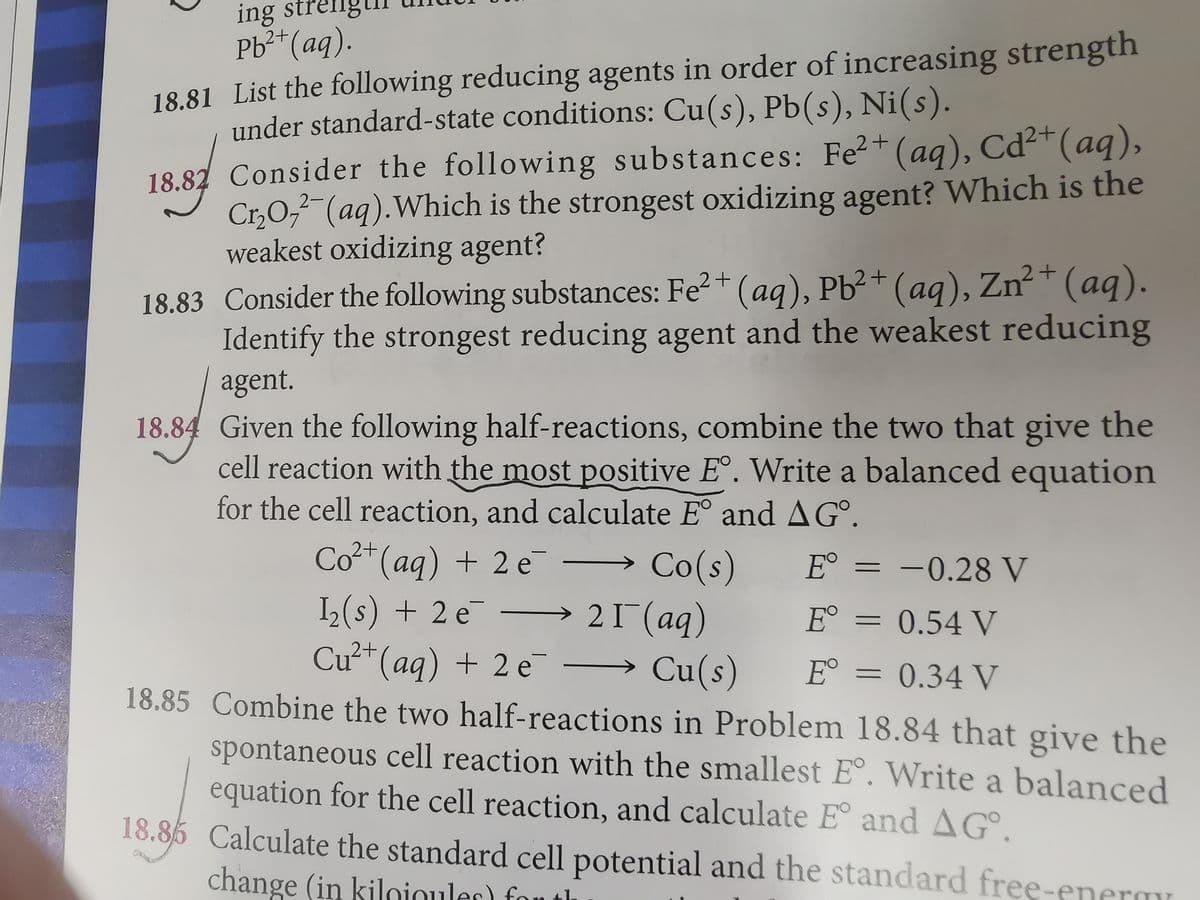under standard-state conditions: Cu(s), Pb(s), Ni(s). 87 Consider the following substances: Fe?+(aq), Cd²+(aq), Cr,0, (aq).Which is the strongest oxidizing agent? Which is the weakest oxidizing agent? 33 Consider the following substances: Fe2+ (aq), Pb²+ (aq), Zn²* (aq).
under standard-state conditions: Cu(s), Pb(s), Ni(s). 87 Consider the following substances: Fe?+(aq), Cd²+(aq), Cr,0, (aq).Which is the strongest oxidizing agent? Which is the weakest oxidizing agent? 33 Consider the following substances: Fe2+ (aq), Pb²+ (aq), Zn²* (aq).
Principles of Modern Chemistry
8th Edition
ISBN:9781305079113
Author:David W. Oxtoby, H. Pat Gillis, Laurie J. Butler
Publisher:David W. Oxtoby, H. Pat Gillis, Laurie J. Butler
Chapter17: Electrochemistry
Section: Chapter Questions
Problem 76AP
Related questions
Question
18.84

Transcribed Image Text:ing streng
Pb²+(aq).
18.81 List the following reducing agents in order of increasing strength
under standard-state conditions: Cu(s), Pb(s), Ni(s).
18.82 Consider the following substances: Fe?+(aq), Cd²*(aq),
Cr,O,²-(aq).Which is the strongest oxidizing agent? Which is the
weakest oxidizing agent?
18.83 Consider the following substances: Fe2+ (aq), Pb²+(aq), Zn²+(aq).
Identify the strongest reducing agent and the weakest reducing
agent.
18.84 Given the following half-reactions, combine the two that give the
cell reaction with the most positive E°. Write a balanced equation
for the cell reaction, and calculate E° and AG°.
Co2* (aq) + 2 e
Co(s)
21(aq)
E° = -0.28 V
L(s) + 2 e
E° = 0.54 V
Cư²*(aq) + 2 e
→ Cu(s)
18.85 Combine the two half-reactions in Problem 18.84 that give the
E°
0.34 V
spontaneous cell reaction with the smallest E°. Write a balanced
equation for the cell reaction, and calculate E° and AG°.
18.86 Calculate the standard cell potential and the standard free-enei
change (in kilojouler) fou tl
+1
Expert Solution
This question has been solved!
Explore an expertly crafted, step-by-step solution for a thorough understanding of key concepts.
Step by step
Solved in 2 steps

Knowledge Booster
Learn more about
Need a deep-dive on the concept behind this application? Look no further. Learn more about this topic, chemistry and related others by exploring similar questions and additional content below.Recommended textbooks for you

Principles of Modern Chemistry
Chemistry
ISBN:
9781305079113
Author:
David W. Oxtoby, H. Pat Gillis, Laurie J. Butler
Publisher:
Cengage Learning

Chemistry: Principles and Practice
Chemistry
ISBN:
9780534420123
Author:
Daniel L. Reger, Scott R. Goode, David W. Ball, Edward Mercer
Publisher:
Cengage Learning

Chemistry: The Molecular Science
Chemistry
ISBN:
9781285199047
Author:
John W. Moore, Conrad L. Stanitski
Publisher:
Cengage Learning

Principles of Modern Chemistry
Chemistry
ISBN:
9781305079113
Author:
David W. Oxtoby, H. Pat Gillis, Laurie J. Butler
Publisher:
Cengage Learning

Chemistry: Principles and Practice
Chemistry
ISBN:
9780534420123
Author:
Daniel L. Reger, Scott R. Goode, David W. Ball, Edward Mercer
Publisher:
Cengage Learning

Chemistry: The Molecular Science
Chemistry
ISBN:
9781285199047
Author:
John W. Moore, Conrad L. Stanitski
Publisher:
Cengage Learning

General Chemistry - Standalone book (MindTap Cour…
Chemistry
ISBN:
9781305580343
Author:
Steven D. Gammon, Ebbing, Darrell Ebbing, Steven D., Darrell; Gammon, Darrell Ebbing; Steven D. Gammon, Darrell D.; Gammon, Ebbing; Steven D. Gammon; Darrell
Publisher:
Cengage Learning

Chemical Principles in the Laboratory
Chemistry
ISBN:
9781305264434
Author:
Emil Slowinski, Wayne C. Wolsey, Robert Rossi
Publisher:
Brooks Cole

Chemistry by OpenStax (2015-05-04)
Chemistry
ISBN:
9781938168390
Author:
Klaus Theopold, Richard H Langley, Paul Flowers, William R. Robinson, Mark Blaser
Publisher:
OpenStax